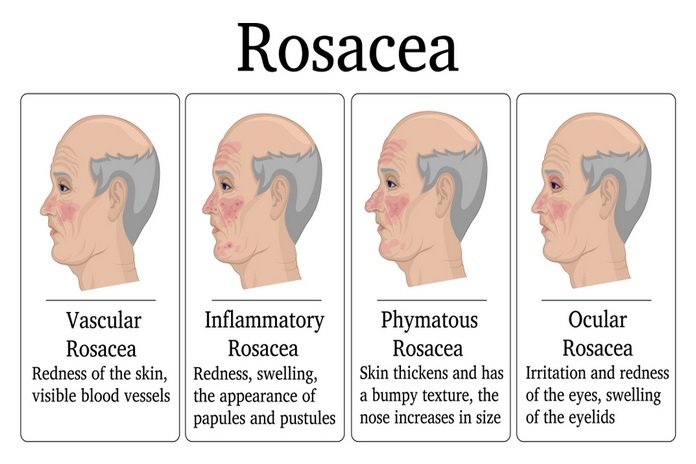Rosacea Types

Rosacea is a severe condition characterized by skin redness that is similar to a sunburn. Redness led by Rosacea sometimes comes and goes at first but by the time it gets long-lasting. Rosacea might be led by several triggers such as caffeine, heat, or stress. NYU Langone healthcare providers can find whether your symptoms are occurring by Rosacea or any other condition, as well as the kind of Rosacea that might be affecting the skin. Rosacea, the condition of the skin characterized by face redness, is a progressive disorder that begins with little symptoms that might advance to more important skin variation if left uncured. (3)
Not everyone has every kind and each kind of Rosacea might affect individuals differently. Some have one, all four, or in between somewhat. Therefore, it is essential to be aware of all the different kinds and their differences as you work to cure your Rosacea. There are four kinds of Rosacea, even though most people have symptoms of more than each type. These four types are discussed in the following:
1- Vascular Rosacea
What used to be referred to as the starting phase or pre-rosacea, is now the first kind of the condition, called vascular Rosacea or erythematotelangiectatic Rosacea. It is characterized by more likely flushing and severe redness of the skin of the face. Few people also observe visible blood vessels creeping over the bridge of your nose and the cheeks.
2- Ocular Rosacea
In ocular Rosacea, signs affect the eyes, leading them to look bloodshot or watery. There might be a link sensation of irritation or burning in the eyes. Ocular Rosacea might lead to sensitive eyes, persistently dry and cysts might form on your eyelids. Ocular rosacea symptoms might be more occurring than previously, even though the link between skin symptoms and the eyes can be overlooked easily. Finding the types or types of Rosacea that might cause your symptoms is just each part of a full diagnosis. It is equally essential for your doctor and you to understand which of the everyday activity and routines might be leading to your symptoms. All the types of Rosacea are diagnosing each type or type that leads to your symptoms and suggestion of treatment by a healthcare provider to enhance the feel and look of your skin.
3- Inflammatory Rosacea
The second type of Rosacea is known as inflammatory Rosacea or papulopustular Rosacea. Its chief symptom is severe redness on the face, as well as an occurrence of red pimples and bumps. These bumps, known as papules and pustules, are different from real acne and need a different cure. Therefore, inflammatory Rosacea is most of the time treated with normal gels such as azelaic acid (Azelex and Finacea), metronidazole (MetroGel and others), or oral medicines, consisting of Oracea (doxycycline).
4- Phymatous Rosacea
Phymatous Rosacea leads to skin scar and thicken, making it swollen, bumpy and sometimes discoloration occurs. This rare but curable kind sometimes affects your nose resulting in what is often known as rhinophyma or bulbous nose and shows more often in men in comparison to women.
